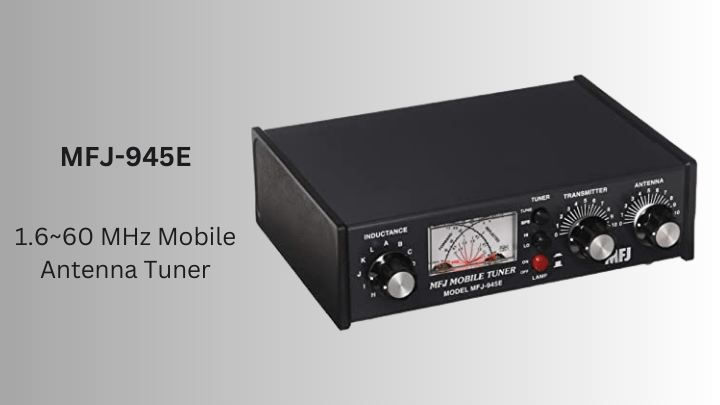To begin with the term ‘Ham radio antenna tuner’, you shall first know about the term ‘Tuning’.
In very basic non technical term; we would use the term ‘tuning’ when we are trying to match two entities (or humans 🙂 ) or anything under consideration. E.g. when we play with our kids, we try to behave as kids and thus ‘tuning’ our mind and thoughts with that of a child’s mind.
In technical terms, antenna tuning is defined as “An electronic device placed between the radio transmitter and the antenna for optimal power transfer by matching impedance of the radio with that of the end of the feed line connected to the antenna”
Some New arrivals for Ham Radio Antenna Tuners are also added at the end of this article.
What is Ham radio antenna tuner || Why it is important?
To understand the role of an ham radio antenna tuner, it’s important to grasp the concept of impedance.
In simple terms; Impedance refers to the opposition encountered by the radio waves as they travel through the transmitter and up to the antenna system.
As per Maximum Power Transfer theory: In order to maximum power transfer from source (i.e. our radio transmitter) to the destination (i.e. end of our Antenna), their impedance must be matched.
The Ham radio antenna tuner acts as a bridge between the transceiver (transmitter + receiver) and the antenna, matching the impedance of both to maximize power transfer. It ensures that the radio waves are efficiently transmitted and minimum power is wasted, leading to improved signal strength, reduced reflections and high quality transmission/reception.
(Know more: 7 Best Mobile Ham Radio for Beginners)
Benefits of using Ham radio antenna tuner
By incorporating an antenna tuner into your ham radio setup, you can enjoy several key benefits:
1. Improved Signal Strength
An antenna tuner allows you to fine-tune your antenna system, maximizing the signal strength and clarity of your transmissions.
2. Expanded Frequency Range
With an antenna tuner, you can operate your ham radio across a wider frequency range, enabling communication on various bands without the need for multiple antennas.
3. Reduced Signal Loss
By minimizing SWR(Standing Wave Ratio), an antenna tuner minimizes signal loss, resulting in more efficient transmission and reception.
4. Enhanced Flexibility
Antenna tuners provide flexibility in adapting your antenna system to different operating conditions, such as changes in frequency or antenna length.
Types of Ham radio antenna tuners
There are basically 03 types of antenna tuners available.
1. Manual Antenna Tuners
Manual antenna tuners are popular among ham radio enthusiasts due to their simplicity and affordability. As the name suggests; all adjustments and settings are done manually through knobs & buttons given with it.
Operating Manual antenna tuners generally involves following steps:
- Connect the antenna tuner to the transmitter and antenna.
- Tune the tuner by adjusting the knobs or switches while monitoring the standing wave ratio (SWR) meter.
- Continuously adjust the tuner until the SWR is minimized, indicating an impedance match.
2. Automatic Antenna Tuners
Automatic antenna tuners provide convenience and speed in matching antenna impedance. They are programmed and utilize motorized components and internal algorithms to automatically do the tuning.
Operating Automatic antenna tuners generally involves following steps:
- Connect the antenna tuner to the transmitter and antenna.
- Activate the tuner, either manually or through automatic detection.
- The tuner will analyze the antenna system and adjust its internal components to achieve an optimal impedance match.
- Monitor the SWR meter and make minor adjustments if necessary to fine-tune the tuning process.
3. Portable Antenna Tuners
Portable antenna tuners are designed for on-the-go ham radio enthusiasts who require flexibility and mobility. They are compact and lightweight, allowing for easy transportation.
Key benefits of using Portable antenna tuners is the ease of setting up temporary stations in outdoor environment. Its very handy during Emergencies & situations of natural disasters when quick communication setups are required.
Choosing the right ham radio antenna tuner
When selecting an antenna tuner, take the following factors into account:
- Power Handling: Ensure the tuner can handle the power output of your transmitter.
- Frequency Range: Verify that the tuner covers the frequency range you intend to operate on.
- Connectivity Options: Check for compatibility with your antenna connectors (such as PL-259, BNC, or N-type connectors).
- Form Factor : Consider the physical size and portability of the tuner, depending on your setup and requirements.
How to setup Ham radio antenna tuner
Setting up an antenna tuner is a straightforward process. Follow these steps for best results:
- Set the Frequency: Tune your ham radio to the desired frequency for operation.
- Initial Tuner Settings: Start with the antenna tuner’s controls set to their default positions.
- Transmitter Output Power: Reduce the transmitter output power to a low setting.
- Tuner Adjustment: Gradually adjust the tuner’s controls while monitoring the SWR meter or using the built-in SWR meter of your radio. Strive to achieve the lowest SWR reading possible.
- Fine-Tuning: Fine-tune the tuner settings for the best possible SWR reading. Remember to re-adjust if you change frequencies or antennas.
- Follow User Manual: Do Follow the manufacturer’s instructions for proper cable connections and grounding.
Recommended Ham radio antenna tuner
- MFJ Enterprises Original MFJ-945E
- 1.6~60 MHz Mobile Antenna Tuner
- Watt Meter & Antenna Bypass Switch

New Arrivals in the Market in USA 2025
No products found.
FAQs on Ham radio antenna tuner
FAQ 1: Can I use an antenna tuner with any type of antenna?
Yes, you can use an antenna tuner with a wide range of antennas. However, the effectiveness of the tuner may vary depending on the antenna design and its inherent impedance characteristics.
FAQ 2: Can I build my own antenna tuner?
Yes, building your own antenna tuner is possible if you have the necessary knowledge and skills in electronics. Numerous resources, including online guides and books, provide circuit diagrams and instructions for DIY antenna tuners.
FAQ 3: Do I need an antenna tuner if my radio has a built-in automatic tuner?
If your ham radio already has a built-in automatic antenna tuner (ATU), you may not need an additional external tuner. The built-in ATU is designed to perform impedance matching and can handle most common antenna configurations.
FAQ 4: Where should I place the antenna tuner in my setup?
Ideally, you should place the antenna tuner as close to the antenna feed point as possible.
Ham radio antenna tuner: Conclusion
Congratulations! You have now gained valuable insights into basic knowledge of ham radio antenna tuner.
Remember, when it comes to achieving the best performance from your ham radio, having a properly matched antenna system is crucial. An antenna tuner plays a pivotal role in achieving this optimal match, resulting in improved signal strength, expanded frequency range, reduced signal loss, and enhanced flexibility.
Start optimizing your ham radio setup today with a high-quality antenna tuner, and experience the difference it can make in your radio communications. Happy tuning!
You may also like to read: Types of ham radio antennas
Other blog posts from the category:
- Ham Radio SWR Meter || How to Choose & Use 1 in 2025
- Ham Radio vs CB vs Walkie Talkie: Choose the Right one USA 2024
- 03 Best GMRS radios for Beginners
- 5 Best Ham Radio Microphones for beginners
- Ham radio base station: Best choices to start with
- Ham Radio Desk: Best Ideas & Top picks 2023
- Ham radio Headsets || Best choices in 2023
- Conquer the Trails: 6 Best Jeep Ham Radios || Updated 2025
- Explore 11+ Best Ham Radio Backpacks: USA 2023
- 7 Best Mobile ham radio for Beginners USA 2023

